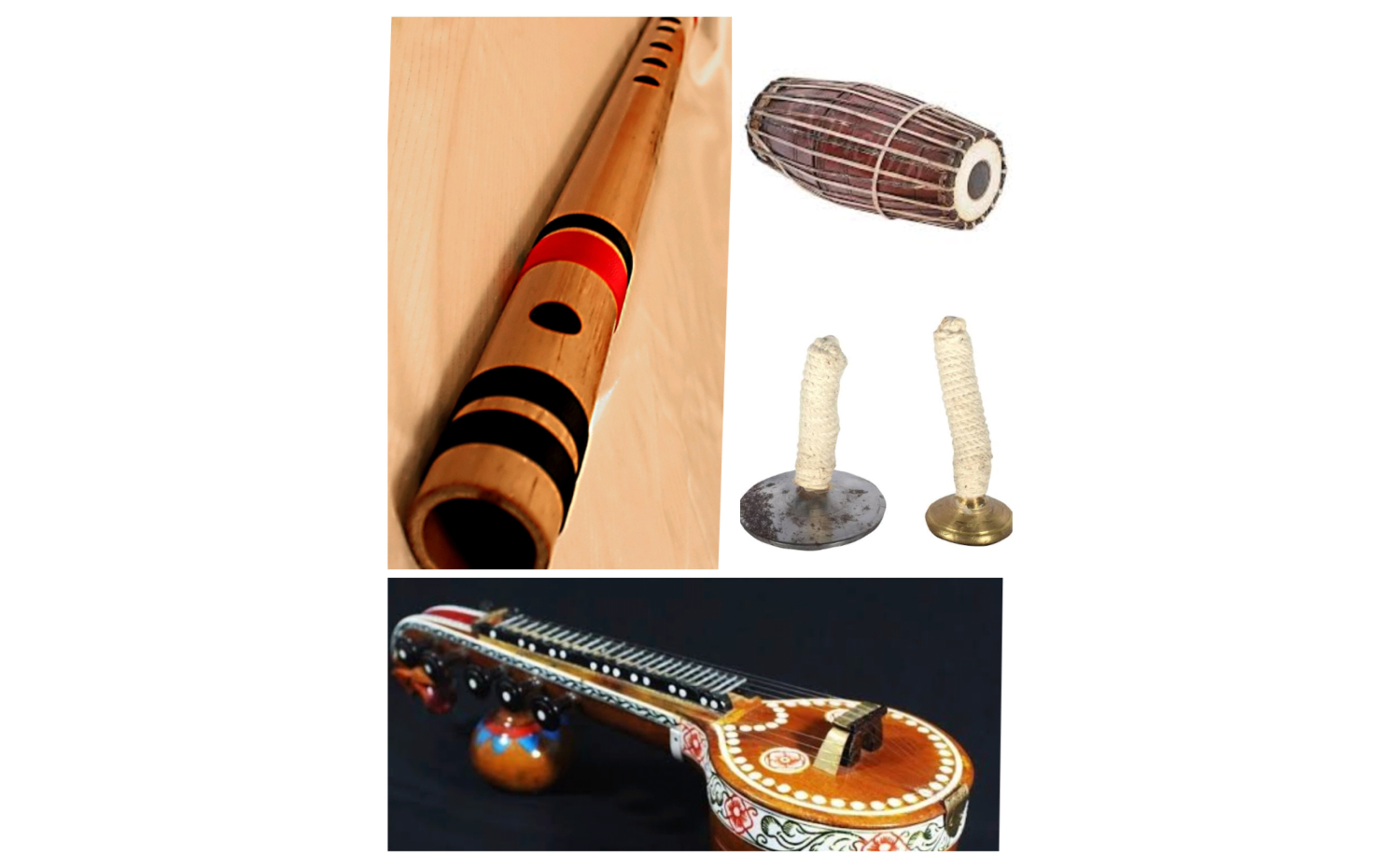“Atodhya Vadya,” as mentioned by Bharata in Chapter 28 of the Natya Shastra, categorizes musical instruments into four types: Tata (stringed), Avanaddha (percussion), Sushira (wind), and Ghana (solid resonators). This classification, based on acoustic principles, highlights the diverse and intricate nature of ancient Indian musical traditions.
- Tata– Included all stringed instruments, mentioned in Chapter 29 of the Natya Sastra.
- Avanaddha– All that were covered or were struck like drums/percussion instruments, mentioned in Chapter 33 of the Natya Sastra.
- Sushira– Included all hollow and wind-blown instruments, mentioned in Chapter 30 of the Natya Sastra.
- Ghana– All solid cymbal-like resonators.
Of these, the stringed and wind instruments that produced flow of pleasant notes seemed to be the favoured ones and were grouped with the singers. They were played individually or in tandem.
Tata Vadya – Among all the stringed instruments, Veena was the most prominent. Veena was a generic term used for all stringed instruments including lutes, and arched harps – with or without frets and plucked with fingers or a plectrum. In fact, till about 19th century, ‘tata vadyas’ were called ‘veena’ whether they were harps like the Chitra Veena, finger board plucked ones like Vipanchi Veena(mentioned in Ramayana), Rudra veena, the Saraswati Veena and Kacchapi Veena(mentioned in Mahabharata), bowed ones such as the Ravan Hasta Veena and the Pinaki Veena (according to renowned scholar Dr. C. Sivaramamurti). The sound of Veena was called by many names- Kana, Nikvan and Nikvaan.
Some say that the Veena referred to in the Natya Sastra might have resembled a harp rather than a lute, as we know it now. The most common veena was bow – shaped and resembled a harp, but there was another type which was more like a guitar. The strings for the Veena were generally 7.
Sushira Vadya – Chapter 30 of the Natya Sastra talks briefly about sushir instruments in about 13 verses. Sushira instruments derived from sushi(hole) stands for wind instruments, in general. They allow passage of air to excite the various resonators. By manipulating the vibrations of air columns, varieties of sound patterns are produced through these instruments. They can be of many types like the conch, horns, trumpets, bugles, and flutes of different types, blown either by mouth or by bellows.
The flute and veena are usually played in unison (Veena- Venu).
Sarangadeva mentions some sushira instruments as Vamsi, Pava, Murali, Kahala, Tundaki, Tunva, Cukka, Sringa and Shankha. Sangit Damodar mentions Pari, Madhuri, Tutturi, Simgha, Vamsi and Turyavamsi as other sushira instruments.
The number of holes on a flute varies. It appears, the early ones had 7 holes. Later, the number was increased to 8.
The music of the Vamsa is steady, not loud, smooth and soothing.
Avanaddha Vadya –
Also called the Pushkara Vadya, they are covered instruments wherein a vessel or a frame is covered with leather. Avanaddha (membranophone) refers to instruments that produce sound primarily by way of a vibrating stretched membrane. These instruments were made by covering a frame of wood or a vessel with a piece of stretched leather that is held together in position by thin and long leather straps.
Avanaddha instruments are classified in several ways- by the rhythm of their beats, by the volume, by the materials that they are made of, by their size, by whether they are drum like, by the manner they are held, by the way they are played and by the context in which they are played. The different avanaddha instruments are mrudanga, panava, aataha, madduka, dundubhi (nagaara), dindima(resembling damru but smaller in size), Muraja, adambara, bheri, pataha( like dholak), and gargara.
Muraja, mrudanga and pushkara are most pleasant to the ear and generally used as musical accompaniments. The darduras, panavas and jarjharikas are other soft-toned drums. The most fearful sound was that of the pretapatahas, or funeral drums.
Ghana Vadya-
The most solid of the ghana vadya is said to be the human body itself. For example, clapping hands, striking palms on thighs or hips, counting fingers or waving the hands. It is said that Cymbals made of metal also called taala are but an extension of the act of clapping to keep time.
Ghana vadyas (idiophone instruments) are made of wood or metal that produce sound when they are struck. The Natya Sastra mentions patah and ghata(bell) also as ghana vadyas. These instruments are usually played with a striker or hammer. They measure time and tempo (kaala and laya) and those who play them should know the rules of taala and laya as well.
The ghana vadys made of metal, are not capable of producing definite pitches that are required for creating a melody. That is why they are not much used in classical music concerts. But, the cymbals, are an essential part of the dance music.
In conclusion, “Atodhya Vadya” in the Natya Shastra presents a profound understanding of ancient Indian musical instruments. The meticulous classification into Tata (stringed), Avanaddha (percussion), Sushira (wind), and Ghana (solid resonators) showcases the rich diversity and complexity of Indian music. Instruments like the Veena and various flutes highlight the sophistication of stringed and wind instruments, while Avanaddha and Ghana Vadyas reveal the rhythmic and tonal dimensions of percussion and solid instruments. This comprehensive framework not only reflects the technical ingenuity of ancient Indian musicians but also their profound appreciation for musical harmony and aesthetic expression.



